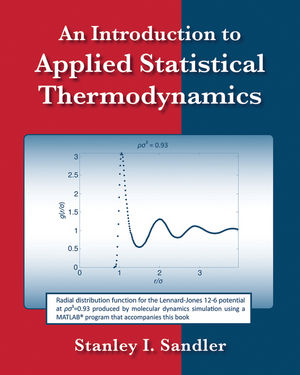|
Textbook
An Introduction to Applied Statistical ThermodynamicsISBN: 978-0-470-91347-5
Paperback
368 pages
November 2010, ©2011
 |
||||||
1.1 Probabistic Description.
1.2 Macrostates and Microstates.
1.3 Quantum Mechanics Description of Microstates.
1.4 The Postulates of Statistical Mechanics.
1.5 The Boltzmann Energy Distribution.
2. The Canonical Partition Function.
2.1 Some Properties of the Canonical Partition Function.
2.2 Relationship of the Canonical Partition Function to Thermodynamic Properties.
2.3 Canonical Partition Function for a Molecule with Several Independent Energy Modes.
2.4 Canonical Partition Function for a Collection of Noninteracting Identical Atoms.
Problems.
3. The Ideal Monatomic Gas.
3.1 Canonical Partition Function for the Ideal Monatomic Gas.
3.2 Identification of b as 1/kT.
3.3 General Relationships of the Canonical Partition Function to Other Thermodynamic Quantities.
3.4 The Thermodynamic Properties of the Ideal Monatomic Gas.
3.5 Energy Fluctuations in the Canonical Ensemble.
3.6 The Gibbs Entropy Equation.
3.7 Translational State Degeneracy.
3.8 Distinguishability, Indistinguishability and the Gibbs' Paradox.
3.9 A Classical Mechanics – Quantum Mechanics Comparison: The Maxwell-Boltzmann Distribution of Velocities.
Problems.
4. Ideal Polyatomic Gas.
4.1 The Partition Function for an Ideal Diatomic Gas.
4.2 The Thermodynamic Properties of the Ideal Diatomic Gas.
4.3 The Partition Function for an Ideal Polyatomic Gas.
4.4 The Thermodynamic Properties of an Ideal Polyatomic Gas.
4.5 The Heat Capacities of Ideal Gases.
4.6 Normal Mode Analysis: the Vibrations of a Linear Triatomic Molecule.
Problems.
5. Chemical Reactions in Ideal Gases.
5.1 The Non-Reacting Ideal Gas Mixture.
5.2 Partition Function of a Reacting Ideal Chemical Mixture.
5.3 Three Different Derivations of the Chemical Equilibrium Constant in an Ideal Gas Mixture.
5.4 Fluctuations in a Chemically Reacting System.
5.5 The Chemically Reacting Gas Mixture. The General Case.
5.6 An Example. The Ionization of Argon.
Problems.
6. Other Partition Functions.
6.1 The Microcanonical Ensemble.
6.2 The Grand Canonical Ensemble.
6.3 The Isobaric-Isothermal Ensemble.
6.4 The Restricted Grand or Semi Grand Canonical Ensemble.
6.5 Comments on the Use of Different Ensembles.
Problems.
7. Interacting Molecules in a Gas.
7.1 The Configuration Integral.
7.2 Thermodynamic Properties from the Configuration Integral.
7.3 The Pairwise Additivity Assumption.
7.4 Mayer Cluster Function and Irreducible Integrals.
7.5 The Virial Equation of State.
7.6 The Virial Equation of State for Polyatomic Molecules.
7.7 Thermodynamic Properties from the Virial Equation of State.
7.8 Derivation of Virial Coefficient Formulae from the Grand Canonical Ensemble.
7.9 Range of Applicability of the Virial Equation.
Problems.
8. Intermolecular Potentials and the Evaluation of the Second Virial Coefficient.
8.1 Interaction Potentials for Spherical Molecules.
8.2 Interaction Potentials Between Unlike Atoms.
8.3 Interaction Potentials for Nonspherical Molecules.
8.4 Engineering Applications/Implications of the Virial Equation of State.
Problems.
9. Monatomic Crystals.
9.1 The Einstein Model of a Crystal.
9.2 The Debye Model of a Crystal.
9.3 Test of the Einstein and Debye Models for a Crystal.
9.4 Sublimation Pressures of Crystals.
9.5 A Comment of the Third Law of Thermodynamics.
Problems.
10. Simple Lattice Models of Fluids.
10.1 Introduction.
10.2 Development of Equations of State from Lattice Theory.
10.3 Activity Coefficient Models for Similar Size Molecules from Lattice Theory.
10.4 Flory-Huggins and Other Models for Polymer Systems.
10.5 The Ising Model.
Problems.
11. Interacting Molecules in a Dense Fluid. Configurational Distribution Functions.
11.1 Reduced Spatial Probability Density Functions.
11.2 Thermodynamic Properties from the Pair Correlation Function.
11.3 The Pair Correlation Function (Radial Distribution Function) at Low Density.
11.4 Methods of Determination of the Pair Correlation Function at High Density
11.5 Fluctuations in the Number of Particles and the Compressibility Equation
11.6 Determination of the Radial Distribution Function of Fluids using Coherent X-ray or Neutron Scattering.
11.7 Determination of the Radial Distribution Functions of Molecular Liquids.
11.8 Determination of the Coordination Number from the Radial Distribution Function.
11.9 Determination of the Radial Distribution Function of Colloids and Proteins.
Problems.
12. Integral Equation Theories for the Radial Distribution Function.
12.1 The Potential of Mean Force.
12.2 The Kirkwood Superposition Approximation.
12.3 The Ornstein-Zernike Equation.
12.4 Closures for the Ornstein-Zernike Equation.
12.5 The Percus-Yevick Equation of State.
12.6 The Radial Distribution Function and Thermodynamic Properties of Mixtures.
12.7 The Potential of Mean Force.
12.8 Osmotic Pressure and the Potential of Mean Force for Protein and Colloidal Solutions.
Problems.
13. Computer Simulation.
13.1 Introduction to Molecular Level Simulation.
13.2 Thermodynamic Properties from Molecular Simulation.
13.3 Monte Carlo Simulation.
13.4 Molecular Dynamics Simulation.
Problems.
14. Perturbation Theory.
14.1 Perturbation Theory for the Square-Well Potential.
14.2 First Order Barker-Henderson Perturbation Theory.
14.3 Second Order Perturbation Theory.
14.4 Perturbation Theory Using Other Potentials.
14.5 Engineering Applications of Perturbation Theory.
Problems.
15. Debye-Hückel Theory of Electrolyte Solutions.
15.1 Solutions Containing Ions (and electrons).
15.2 Debye-Hückel Theory.
15.3 The Mean Ionic Activity Coefficient.
Problems.
16. The Derivation of Thermodynamic Models from the Generalized van der Waals
Partition Function.
16.1 The Statistical Mechanical Background.
16.2 Application of the Generalized van der Waals Partition Function to Pure Fluids.
16.3 Equation of State for Mixtures from the Generalized van der Waals Partition Function.
16.4 Activity Coefficient Models from the Generalized van der Waals Partition Function.
16.5 Chain Molecules and Polymers.
16.6 Hydrogen-bonding and Associating Fluids.
Problems.



